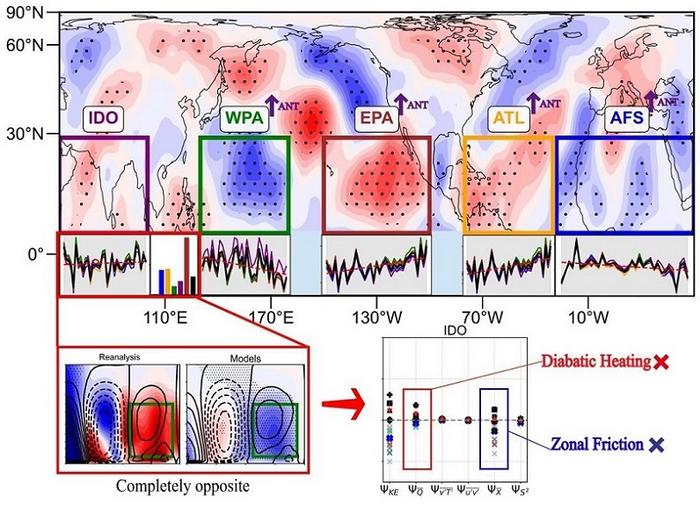The Discrepancy in Hadley Circulation Intensity Changes: A Path to Clarity
The Hadley circulation represents a crucial element of Earth’s atmospheric dynamics, responsible for the transport of warmth and moisture from the equatorial regions to the mid-latitudes. As one of the primary components of the global climate system, the behavior of this circulation can significantly impact weather patterns and climatic conditions worldwide. Researchers have noted that recent observations and predictions regarding the Hadley circulation have become a topic of heated debate, particularly due to inconsistencies between reanalysis data and climate model outputs. As scientists delve deeper, a clearer understanding of these discrepancies emerges.
Recent research highlighted in the esteemed journal Atmospheric and Oceanic Science Letters sheds light on the troubling mismatch between observed strengthening trends in the Hadley circulation, as indicated by reanalysis datasets, and climate models that suggest a decline in its intensity. These conflicting perspectives invite a critical investigation, as the implications are vast for our understanding of global climate dynamics. This study specifically zeroes in on the Northern Hemisphere, where regional trending reflects a more nuanced and complex scenario.
Prof. Bo Sun, who leads the research from the Nanjing University of Information Science and Technology in China, identifies regional Hadley circulation intensity trends as a key area of focus. The study painstakingly evaluates variations across six critical regions which include the eastern Pacific, western Pacific, Atlantic, Africa, Indian Ocean, and other residual areas. Employing an array of 6 distinct reanalysis datasets alongside 13 leading climate models, the research strives to unravel the elements that contribute to the observed discrepancies.
A notable finding from this investigation indicates that the Indian Ocean’s regional trends significantly contribute to the observed differences between reanalysis sources and climate models. While observational data presents a narrative of strengthening Hadley circulation in this area, climate models counter with a consistent portrayal of weakening trends. These contrasting depictions beg the question: what underlying mechanisms are responsible for such pronounced divergence?
To answer this, the research scrutinizes critical factors such as diabatic heating and zonal friction. These elements play essential roles in shaping the atmospheric circulation patterns, and their representation in climate models raises critical concerns about the fidelity of these simulations. A deeper comprehension of how models capture (or fail to capture) these dynamics could pave the way for improved predictive capabilities regarding regional and global climate phenomena.
Furthermore, the study employs optimal fingerprint analysis, revealing that external factors related to greenhouse gas emissions largely suppress Hadley circulation changes across most regions studied. With anthropogenic influences—such as greenhouse gas emissions and aerosols—firmly positioned at the center of this investigation, the findings emphasize the profound impact human activities exert on atmospheric processes. Particularly in the African region, the extent of anthropogenic external forcing, particularly from aerosols, plays a pivotal role in influencing local Hadley circulation trends.
The study does not shy away from addressing the broader implications of these findings regarding climate models. It strongly argues for improved representations of regional variations in Hadley circulation within climate models, insisting that such advances are paramount for enhancing the accuracy of future atmospheric predictions. Without incorporating more precise simulations of regional dynamics, the ability of climate models to inform policymakers and the public about impending climate changes remains limited.
Enhancing the representation of physical processes involved in regional Hadley circulation is not merely an academic exercise; it carries real-world repercussions. As climate variability intensifies, understanding the intricacies of atmospheric circulation becomes increasingly vital. With many aspects of climate models still in need of upgrading, identifying and implementing these advancements will be paramount in bridging the existing gaps between model predictions and observed data.
Significant insights have emerged from this research, underscoring a critical need for focused investigations into the regional behaviors of atmospheric phenomena. As scientists seek to navigate the complex interactions at play within the Hadley circulation, it is evident that human activity cannot be overlooked. The implications of anthropogenic forcing extend beyond mere statistical analysis; they demand a comprehensive reevaluation of how climate change is modeled and addressed.
The study ultimately conveys a sense of urgency regarding the need for continued research into the regional nuances of atmospheric circulation. As we step further into an era marked by climate change, clarity regarding the mechanics underlying phenomena like the Hadley circulation becomes a collective priority. This comprehensive understanding is necessary, not only to enhance the resolution of climate models but also to foster adaptive strategies that could mitigate future climatic impacts.
In conclusion, as research builds upon these findings, the promise of improved predictive capacities rests on enhancing our understanding of Hadley circulation dynamics. The ongoing collaboration between observational data and advanced climate modeling will be essential. Only through such integrative approaches can we hope to unravel the complexity of Earth’s climate system and address the daunting challenges posed by climate change effectively.
Subject of Research: Hadley circulation intensity changes in the Northern Hemisphere
Article Title: Attribution of regional Hadley circulation intensity changes in the Northern Hemisphere
News Publication Date: 7-Mar-2025
Web References: http://dx.doi.org/10.1016/j.aosl.2025.100613
References: None Available
Image Credits: Yi Zheng
Keywords
Atmospheric dynamics, Climate Modeling, Hadley Circulation, Climate Change, Atmospheric Science.




